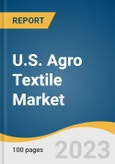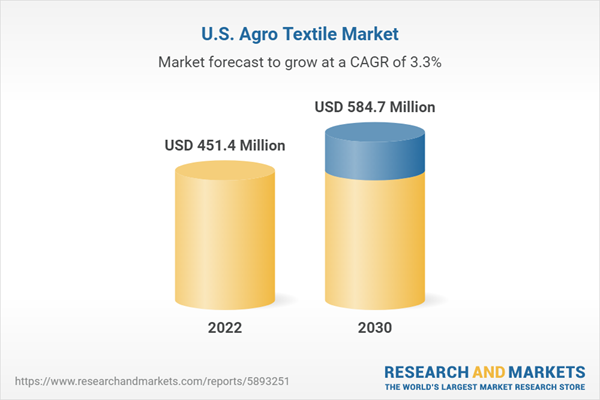The U.S. agro textile market size is expected to reach USD 584.7 million by 2030, growing at a CAGR of 3.3% during the forecast period. This growth is attributed to the growing demand for agricultural products and technological advancements in agrotechnology.
The need to increase agricultural production has pushed manufacturers in the agricultural sector to come up with alternatives to traditional methods, such as soil additives, that help them. The limited availability of natural resources used in farming activities and stringent rules by governing bodies regarding materials, such as a number of pesticides, have made technological advancement a major factor in increasing agricultural productivity. Recent times have seen a rise in R&D activities in agricultural technology that has made a significant impact on the use of agrotextiles by incorporating them into newer methods and modifying the textile itself to become more efficient.
The increasing use of greenhouses and innovation in the materials used for greenhouses has helped boost innovation in agro textile industry in the U.S. Shade nets with properties such as UV protection, sunlight reflection, and breathable fabrics are increasingly opted for by consumers for their use in greenhouses and terrace farming.
Modern users are shifting toward techniques such as soilless farming. Increasing urbanization is decreasing the land available for farming practices. The growth and nutrient potential of available land is going down, which has made it tougher to increase yield without using chemical alternatives that are harmful to the environment. The use of chemical alternatives at different stages of farming is likely to reduce the quality of the produce. Soilless farming is a suitable alternative for manufacturers using techniques such as aeroponics, hydroponics, and aquaponics. This is useful in urban areas where there is a limitation of available land for farming.
The uncertainty in resources such as water and land coupled with other environmental factors such as pests and climate fluctuations has led farmers to use agro-technology to keep up their production levels. The use of technology in agricultural activities is expected to increase crop yield. Rising demand for high-quality food is expected to drive the agro textile market in the U.S. on account of the increasing product use in different farming practices.
The need to increase agricultural production has pushed manufacturers in the agricultural sector to come up with alternatives to traditional methods, such as soil additives, that help them. The limited availability of natural resources used in farming activities and stringent rules by governing bodies regarding materials, such as a number of pesticides, have made technological advancement a major factor in increasing agricultural productivity. Recent times have seen a rise in R&D activities in agricultural technology that has made a significant impact on the use of agrotextiles by incorporating them into newer methods and modifying the textile itself to become more efficient.
The increasing use of greenhouses and innovation in the materials used for greenhouses has helped boost innovation in agro textile industry in the U.S. Shade nets with properties such as UV protection, sunlight reflection, and breathable fabrics are increasingly opted for by consumers for their use in greenhouses and terrace farming.
Modern users are shifting toward techniques such as soilless farming. Increasing urbanization is decreasing the land available for farming practices. The growth and nutrient potential of available land is going down, which has made it tougher to increase yield without using chemical alternatives that are harmful to the environment. The use of chemical alternatives at different stages of farming is likely to reduce the quality of the produce. Soilless farming is a suitable alternative for manufacturers using techniques such as aeroponics, hydroponics, and aquaponics. This is useful in urban areas where there is a limitation of available land for farming.
The uncertainty in resources such as water and land coupled with other environmental factors such as pests and climate fluctuations has led farmers to use agro-technology to keep up their production levels. The use of technology in agricultural activities is expected to increase crop yield. Rising demand for high-quality food is expected to drive the agro textile market in the U.S. on account of the increasing product use in different farming practices.
U.S. Agro Textile Market Report Highlights
- The synthetic fiber segment dominated the market with the largest revenue share of 68.0% in 2022. Synthetic fibers, such as polypropylene, polyethylene, and polyester, are known for their high tensile strength and durability. They can withstand the stresses imposed by agricultural practices and environmental conditions, making them suitable for long-term use
- The knitted agro textile segment is expected to grow at the highest CAGR of 3.5% over the forecast period. This is due to the inherent flexibility of knitted fabrics, which allows them to adapt to the contours of the crop or the agricultural structure. Moreover, the ease of handling knitted fabric and the versatility, in terms of the usage of textiles made by knitting methods, have led to an increase in demand for agro textiles in the U.S.
- The fishing nets end-use segment accounted for the highest revenue share of 70.0% in 2022. The surging application of aquatic life in various industries, including nutraceuticals, pharmaceuticals, and cosmetics, as well as the increasing consumption of seafood, has contributed to the expansion of aquaculture, resulting in a substantial boost to the growth of the fishing net segment
- Agro textiles made from natural materials such as jute, wool, and cotton are used in applications wherein the textile has to be biodegradable. They are also developed from manmade fibers such as nylon, polyester, and polyethylene, which are highly durable and cost-effective
- Nonwoven agro textiles are more efficient than their woven counterparts as they are lightweight and offer increased protection and breathability. These textiles are treated to make them water-repellent, antibacterial, antifungal, UV-resistant, heat-resistant, non-toxic, and non-irritating
Table of Contents
Chapter 1. Methodology and Scope
Chapter 2. Executive Summary
Chapter 3. U.S. Agro Textile Market Variables, Trends & Scope
Chapter 4. U.S. Agro Textile Market: Material Estimates & Trend Analysis
Chapter 5. U.S. Agro Textile Market: Type Estimates & Trend Analysis
Chapter 6. U.S. Agro Textile Market: End-Use Estimates & Trend Analysis
Chapter 7. Competitive Landscape
List of Tables
List of Figures
Companies Mentioned
- TenCate Geosynthetics
- Belton Industries, Inc
- Mogul Co., Ltd.
- Dewitt
- Freudenberg Performance Materials
- Siang May Pte Ltd.
- Ludvig Svensson
- Mink (Phorium)
- Morenot
- Garware Technical Fibers Ltd.
Methodology

LOADING...
Table Information
| Report Attribute | Details |
|---|---|
| No. of Pages | 100 |
| Published | September 2023 |
| Forecast Period | 2022 - 2030 |
| Estimated Market Value ( USD | $ 451.4 Million |
| Forecasted Market Value ( USD | $ 584.7 Million |
| Compound Annual Growth Rate | 3.3% |
| Regions Covered | United States |
| No. of Companies Mentioned | 10 |









